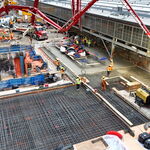Streety McCarface
Senior Member
Used to live in Tokyo and Chicago, visit all over the place. The issue here is not that the design is inherently bad for a tram, but it sucks for light rail, especially Toronto light rail. Our system is objectively more crowded (meaning less space for passengers, not having the most passengers) than any other system in Canada and the United States. I don't genuinely have a problem with the width of light rail vehicles, but the way they've laid out the seats is both extremely uncomfortable and awkward. With low floor light rail without steps, you can't get around the narrow walkway, but you can avoid the 4 seats facing each other. I understand that the bogies are underneath, but you can still have step up sections to seats facing inward, similar to articulated buses:Never been inside a tram, light rail vehicle, metro, or tube car outside of Toronto, I see.
In reference to the 4 seats facing each other that are not on top of the bogies, you can have all the seats face one direction instead of each other:
(It's a high floor vehicle, yes, but the point still stands).
Just give us more standing room, we don't need to cram as many people as possible onto seats. I for one don't mind standing on a 15 minute train ride. Even though sitting is nice, it's much worse than standing if you can't get off at your stop or if your legroom is limited by the legs of the person in front of you. There are better ways to do this, even if we want 100% low floor vehicles.
EDIT: Most North American subway cars tend to be nearly as wide as Toronto's, and if they aren't, the seating is all inward facing to improve space for standees. I wouldn't have a problem with the seating design if ridership on the finch west corridor wasn't so high, but this line is likely to see at least 40K passengers per day when it opens, so optimizing the trains for more standing room makes a lot of sense.





